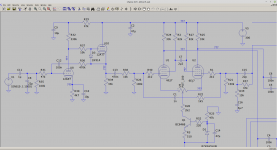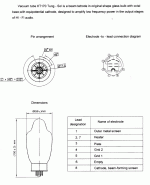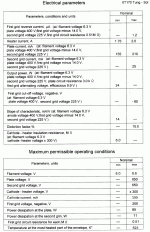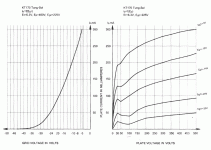But in any case, personally i dont think its worth it, just because there are types like the GU50 around which is a crazy well built tube but has some drawbacks like : Large spread in production parameters and low VG2 specification. However in triode these are absolutely fantastic and something that overbuilt is NEVER going to be made again.
I’m curious why the GU50 needs such a high load impedance. Don’t people typically use 8-10k to get 100 watts? Sweep tubes get there with 1/3 of that impedance.
I used to work with 50awg magnet wire but it looks like 23uM has me beat. I agree the bottle is ugly.
50 AWG is a bitch too!
It is wirebonding wire so absolutely not meant for winding by hand and such, in the end we found a way to work with just a straight piece of wire. But we got a patent and a paper out of it so it was worth the frustration 😀
https://patentimages.storage.googleapis.com/78/89/c8/22dc9af27cf428/US20200284813A1.pdf
The hot-wire concept: Towards a one-element thermal biosensor platform - ScienceDirect
But good to see that I'm not the only one who dislikes that shape. The KT150 looks pretty futuristic, this just looks malformed
I believe it's due to the massive cathode in the sweep tubes that do that.
I could be wrong. George would know.
I could be wrong. George would know.
I’m curious why the GU50 needs such a high load impedance. Don’t people typically use 8-10k to get 100 watts? Sweep tubes get there with 1/3 of that impedance.
Depends on what curves we are looking at. I always figured you can use 3K5/5K for the GU50 in SE. But i could be entirely off the mark il find some triode curves for that Stalinbottle and get back to you.
The history behind the GU50 is somewhat unknown, apparently the Russians pretty much took everything that wasnt bolted down or fixed to heavy concrete back to Russia after WW2 so the tooling for the LS50 ended up in Russia.
The application for the LS50 was in bombers for the German air force. And it was used in applications where Key down the normal power dissipation would be exceeded.. So the anodes are quite thick, solid nickel. The Russians improved upon that with sintered on Zirconium.
What is surprising is that this is a 50W tube with pretty low heater current requirements for the time.
The LS50 has a massive metallic pin in the centre of the tube, what is surprising is that the socket of the GU50 also has a bend in the internal shield, so i think LS50 aught to fit in that socket.
Yeah there is a definite advantage to lower anode impedance.. easier to make good BW transformers. Toroidy is on my list to try sometime.
Lets Begin a list of sleeper tubes? Im sure i can have the Mods make it a sticky.
Just a list of anything available NOS under 10USD per tube.
First thing on the list: EF184/6EJ7 they literally made the tube by the millions. NOS can be found in practically every brand for decent prices. Same applies for the EC family of tubes. Want something as linear as E288CC but dont want to pay the price? EC86 E86C/EC806S may do the trick.
Classicvalve.ca - when they were still selling boards - had an upgrade board for the ubiquitous ST-70 in the Mullard configuration called the DynaMull that used the 6EJ7.
I find this spec sheet far from usable. All numerical data is blocked !
?? I do not know what to say. I see numerical data. Ample to design an amplifier, considering it is only a big KT88. Maybe it is a flawed PDF?
Attachments
That means they are either seeing the traffic to the server or sone EHX engineer is on this forum as well.
What id like to see in the datasheet is factory anode current tolerances used in testing. and at this price-point, perhaps a QR code on the base you can read with your phone to get the factory test data for your tube. so you can see when IA has dropped below 70%
For the rookies it may be wise to put some suggested PP operating specifications in the datasheet. And lest not forget maximum grid leak in fixed bias.
This is not a true KT type looking at the curves.
Im gonna stop bashing EHX now, its actually very nice that they came out with something new.
If they are looking for new ideas: they can likely get their hands on the GU50 tooling and septar bases to make EL152”s if they take a different pitch for G2 they could make a nice tube suitable for UL operation.
What id like to see in the datasheet is factory anode current tolerances used in testing. and at this price-point, perhaps a QR code on the base you can read with your phone to get the factory test data for your tube. so you can see when IA has dropped below 70%
For the rookies it may be wise to put some suggested PP operating specifications in the datasheet. And lest not forget maximum grid leak in fixed bias.
This is not a true KT type looking at the curves.
Im gonna stop bashing EHX now, its actually very nice that they came out with something new.
If they are looking for new ideas: they can likely get their hands on the GU50 tooling and septar bases to make EL152”s if they take a different pitch for G2 they could make a nice tube suitable for UL operation.
Last edited:
Could someone please tell me what’s wrong with paralleling KT88’s? Looking at the curves, and that 15% distortion figure in SE, I really have to wonder if bigger is better since there *is* another way to do it - one with multiple sources for the tubes. Every experience I’ve had with transistor amps says there is a practical limit to power transistor size (as a linear amplifier) and that’s about 200 watts (25C power dissipation). Attempts to make bigger ones are fraught with problems and were ultimately abandoned. Larger amps just parallel them. Reliability has just plain been better that way.
The curves don’t look all that good. Unless they’d be better with a more reasonable Vg2 - how bout they publish it? You have to wonder if these bigger valves have problems with thermal runaway. Bigger transistors do (the SOA of a 600 watt switching hexfet is horrible - you can’t build a class AB amp with them). Voltages have to climb - on octal sockets with normal wiring techniques eventually something’s gotta give. What if they go away in 10 years, and you need a retube?
The curves don’t look all that good. Unless they’d be better with a more reasonable Vg2 - how bout they publish it? You have to wonder if these bigger valves have problems with thermal runaway. Bigger transistors do (the SOA of a 600 watt switching hexfet is horrible - you can’t build a class AB amp with them). Voltages have to climb - on octal sockets with normal wiring techniques eventually something’s gotta give. What if they go away in 10 years, and you need a retube?
Tubes tend to scale well. Look at how large some of the transmitting tubes are. The 304tl is a good example where you can get lots of clean power in SE and it also has data for running in AB1. Who really manufactures Tung Sol now? It could just be a bad design. I would look at transmitting tubes with similar dissipation rating as a comparison.
I like the idea of new tube types being manufactured but yeah longevity could be a problem. Look at amps designed about the 7591/7868.
I like the idea of new tube types being manufactured but yeah longevity could be a problem. Look at amps designed about the 7591/7868.
As far as I know, Tung-Sol are made at the former Reflektor factory in Saratov (Xpo-pul).
Last edited:
There's nothing wrong with 2xKT88 in parallel. I was just interested in the fact a new valve had come out. I tend to agree that the KT120/KT150 are not as linear.
Is there REALLY a difference between any of the New Sensor brands, all made in the same factory as the old Sovtek? New production Gold Lion and Mullard costing a bit (but only a bit) more than EH or Tungsol, but other than the fancy printing on the glass look alike inside.
For my money, I think I’d buy two KT88 rather than a single 170. If I was looking for a “big” tube I think I’d be looking at transmitting types that have been around and are a proven design. The 150 and 170 look pretty - more menacing than a typical audio tube, but so do sweeps and transmitters with top caps. From those distortion figures I’m not sure I’d want one in a SET, where you want one big beautiful tube to look at. Maybe they’d work well in an UnSET, but I don’t think George would spend that much to find out (he’s a cheapskate at heart and so am I).
I would certainly be concerned about new production 7591s in older vintage equipment. Maybe they’re ok if used within ratings, but most applications like the old Fisher and HH Scott took liberties with the Vg1 resistance. I’ve had “newer” Philips ECG 7868s go into runaway in those recievers, where the old Pre-Philips Sylvanias they came with continued to work fine even with cracks in the glass (why I tried replacing them). I’ll bet the EHs are worse in that regard. For new design you can just drive from a lower resistance source and not have a bit of trouble, but that doesn’t help vintage equipment.
For my money, I think I’d buy two KT88 rather than a single 170. If I was looking for a “big” tube I think I’d be looking at transmitting types that have been around and are a proven design. The 150 and 170 look pretty - more menacing than a typical audio tube, but so do sweeps and transmitters with top caps. From those distortion figures I’m not sure I’d want one in a SET, where you want one big beautiful tube to look at. Maybe they’d work well in an UnSET, but I don’t think George would spend that much to find out (he’s a cheapskate at heart and so am I).
I would certainly be concerned about new production 7591s in older vintage equipment. Maybe they’re ok if used within ratings, but most applications like the old Fisher and HH Scott took liberties with the Vg1 resistance. I’ve had “newer” Philips ECG 7868s go into runaway in those recievers, where the old Pre-Philips Sylvanias they came with continued to work fine even with cracks in the glass (why I tried replacing them). I’ll bet the EHs are worse in that regard. For new design you can just drive from a lower resistance source and not have a bit of trouble, but that doesn’t help vintage equipment.
I don't have a spice model with the KT170 but a pair of KT150 produced rather a flattened sinewave at the grid drive when NFB was in place. This is a good indication of poor output non linearity. They tend to have too much gain at low grid voltages. I don't know whether to 40% UL taps don't suite the KT150. A pair of KT88's are much better with the distortion. I guess its a toss up between a fancy looking valve or 2xKT88 in each half of the PP. I would go KT88. There is some attraction of pretty - I guess that why 300B triode has become popular with its direct heater drive challenge but that's controversial. The best of the lot seems to be the 6550 which is what I use.
Last edited:
Give me a triode strapped 6P45S over the KT*** any day 🙂 Completely different tubes and OP but 100W out of a pair as triodes is nice.
Give me a triode strapped 6P45S over the KT*** any day 🙂 Completely different tubes and OP but 100W out of a pair as triodes is nice.
In your experiments with the 6P45S what B+? screen voltage? current? load? I would be willing to mock up something as those tubes are pretty cheap.
I think you would be pushed to get 100W out of a pair in triode mode. You are limited to 300V HT. I was looking for a model to simulate.
I got a datasheet with all of the numbers blocked out yesterday.
Looks like a real tetrode though it may handle UL connection and other abuse better than a typical pentode. The knee in the 50ma plate current range looks bad though a typical amplifier may never go there. Wish they had better curves.
wg_ski - I think the tube needs to be as big as possible as a selling point. Many amplifier manufacturers want to show up at RMAF or some other show with the biggest tube.
Paralleling 6550s or KT88s makes sense but you do not have a really big tube.
Looks like a real tetrode though it may handle UL connection and other abuse better than a typical pentode. The knee in the 50ma plate current range looks bad though a typical amplifier may never go there. Wish they had better curves.
wg_ski - I think the tube needs to be as big as possible as a selling point. Many amplifier manufacturers want to show up at RMAF or some other show with the biggest tube.
Paralleling 6550s or KT88s makes sense but you do not have a really big tube.
Last edited:
In your experiments with the 6P45S what B+? screen voltage? current? load? I would be willing to mock up something as those tubes are pretty cheap.
I usually use 320V B+, triode connected 240R, load 650R:4R, 1k:6R, 1k3:8R Ra-a, idle at 100 to 120mA.
360V is possible in triode but 320V is easily made with a voltage doubler from 120V isolation (cheap).
I think you would be pushed to get 100W out of a pair in triode mode. You are limited to 300V HT. I was looking for a model to simulate.
I use 320V, but 360V is fine apparently. I know I used to use 360V on the 6P36S trioded. They (45) will move ~1.4A of current (0V grid 1) so 100W is easy.
Push pull of course.
Last edited:
- Home
- Amplifiers
- Tubes / Valves
- KT170



